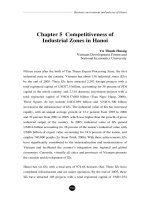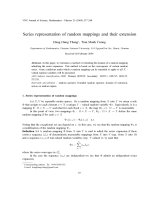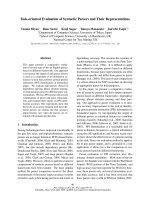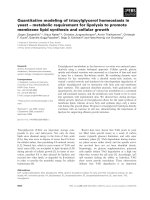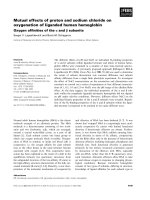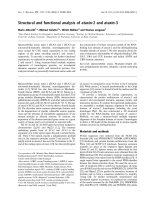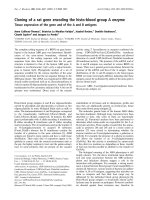Scientific report: "Loss of land due to construction of industrial zones and rural employment" potx
Bạn đang xem bản rút gọn của tài liệu. Xem và tải ngay bản đầy đủ của tài liệu tại đây (185.76 KB, 12 trang )
J. Sci. Dev. 2009, 7 (Eng.Iss.1): 112 - 122 HA NOI UNIVERSITY OF AGRICULTURE
112
Land loss for industrial zones and rural employment
Mất đất do xây dựng khu công nghiệp và việc làm nông thôn
Ngo Trung Thanh
Faculty of political and social science
TÓM TẮT
Sau 15 năm phát triển, Việt Nam đã xây dựng được 49 khu công nghiệp tập trung tại 61 tỉnh,
thành phố. Tuy nhiên, tỷ lệ lao động của các hộ mất đất để xây dựng khu công nghiệp có được việc
làm từ các khu công nghiệp là thấp. Vậy tại sao lao động của các hộ này thất bại trong quá trình
chuyển đổi nghề nghiệp, bao gồm thất bại trong quá trình tìm kiếm việc làm tại các khu công nghiệp
và tạo việc làm từ các khoản được đền bù? Bài viết này dựa trên nghiên cứu sự ảnh hưởng của khu
công nghiệp tới việc làm nông thôn để làm rõ vấn đề trên.
Từ khóa: Khu công nghiệp, mất đất, việc làm.
SUMMARY
During more than 15 years of development, IZs have appeared in 49 of 61 provinces and cities of
Vietnam. However, the proportion of labor in land loss households accessed to employment
opportunities in the industrial zone is low. So, why the labor of land loss household failed to get
alternative employment, including the employment provided by the enterprise in the IZ and the
employment generated by compensation? This article reports on a study of the impact of industrial
zones on rural employment to contribute at understanding this.
Key words: Employment, industrial zone, land loss.
1. INTRODUCTION
To date, industrial zones (IZs) or export
processing zones (EPZs) are common all over the
world, and applied to attract investments to boost
national economy. In fact, these zones provide a
huge number of non farm employment (Huang,
2001; ILO, 2002; ILO, 2007; Rondinelli, 1987).
The success of IZs in term of employment
generation can be explained that their field of
production is based on labor intensive industries
which find in early stage of industry development
in developing countries. The industries attracted to
the zones are predominantly food processing,
garment and textile, electrical appliance and
components, metal product, optical instrument, and
toys and crafts manufacturing and assembling
activities that depend on cheap labor to perform
routine and repetitive tasks (Rondinelli, 1987).
Actually, the zones generated employment for
women rather than man (Amirahmadi & Wu, 1995;
ILO, 2002; ILO, 2007; Kusago & Tzannatos, 1998;
Ramanayak, 1982; Reigstad, 2007; Rondinelli,
1987). The employment created by the zones is
considered as instability and low wages (ILO,
2002; Jauch, 2002; Kusago & Tzannatos, 1998;
Rondinelli, 1987; Sricharatchany, 1983).
During more than 15 years of development, IZs
have appeared in 49 of 61 provinces and cities of
Vietnam (Huy, 2007). One of the aims of IZs is to
create employment for people living around, but it
seems to be a failure rather than a gain. Dung (2006)
found that the IZs provided about 960 thousand
employments, but they caused the loss of 680
employment of land loss households (Phong, 2006).
Within the land loss households, on average, 1.5
labors per household have lost their work.13 labors
per ha have been lost their work in agriculture.
During 2000-2004, 50 percent of labors that lost
their agriculture work due to land conversion have
been fallen into unemployment (Cuong, 2006).
Moreover, the proportion of laborers employed from
Land loss for industrial zones and rural employment
113
the households that lost agricultural land for building
IZs is low, even of retrained labor. The survey of
ADB (2005) found that the employment created by
IZs for land loss households is eight percent of
interviewed households in Long An and Can Tho,
and five percent in Vinh Phuc and Ha Tay. It also
showed that more than 60 percent of land conversion
households can generate more income after land
conversion. For the rest, it causes disruption in
household economy, particularly if all productive
landholdings are lost, residence is disrupted,
insufficient notice is given by the local authorities
and family members do not have appropriate
educational background or vocational skills to shift
into new occupations. Furthermore, the scale of state
support to land loss households appears to vary
between provinces, but is generally low. Access to
retraining opportunities was 28 percent of surveyed
households in Binh Dinh, two percent in Quang
Nam, and four percent in Long An and Can Tho
(ADB, 2005).
In case of labors in the land loss households
paid themselves for extra education or training at
vocational schools, many of them could not find a
job. In Ha Noi, for each 1,000 land loss people,
there are 190 with self payment education or
training, and 100 people who could not find job.
This number is 300 and 180 in Bac Ninh province;
450 and 350 in Can Tho province (Cuong, 2006).
So, why the labor of land loss household
failed to get alternative employment, including the
employment provided by the enterprise in the IZ
and the employment generated by compensation?
The overall objective of study is to analyze impact
of industrial zones on rural employment. Specific
objectives are to analyze the formation of Que Vo
IZ and its employment provision for land loss
households; analyze employment transition after
land loss; and analyze the usage of compensation
with the link to generation of alternative
employment of land loss households.
2. METHODS
The case study was conducted in Bac Ninh
which is the smallest province of Vietnam. It has
50.8 percent of agricultural land converted to the
building of IZs. Compared to other provinces, this
proportion of Bac Ninh ranked second, after Ha
Tay (Cuong, 2006). To 2006, four IZs had been
established with 1956 ha. As provincial plan, the
number of IZs will increase to 8, and area will
widen to about 3000 ha in the period of 2010-2015.
Within four existing IZs, Que Vo and Tien
Son are the largest ones. They all have 300 ha and
have already operated. The land for Que Vo IZ was
converted from agricultural land of Van Duong,
Nam Son and Phuong Lieu commune. Son Trung
and Thai Bao village in Nam Son commune was
chosen for analyzing because they all relied
agriculture before the building of the Que Vo IZ.
Currently, Son Trung does not loss agricultural
land, meanwhile, Thai Bao has lost ninety percent
of agricultural land for the Que Vo IZ.
The data collected includes the way Que Vo
IZ was formed, the changes of employment before
and after the building of Que Vo IZ, the usage of
compensation and other assistances, and some
reasons of the failure of villagers in getting
employed by enterprises in the IZ. The qualitative
data was obtained by group discussion interviews
and in-depth interviews. The quantitative data was
collected by surveying 134 households, of which,
82 households that had their agricultural land loss
(in Thai Bao village) and 52 households that remain
agricultural land (Son Trung village). These
households account for 30 percent of both surveyed
villages. It was analyzed by using descriptive
statistic such as mean, frequency, crosstab.
Comparing these villages before and after land loss
has been used as analytical framework. At survey
time, land acquisition and compensation delivery
have already finished for a year, so it is considered
as the time after land loss.
3. RESULTS AND DISCUSSION
3.1. How Que Vo IZ was formed? -
Organizational relations
At the end of 1990s and early of 2000s, Bac
Ninh’s provincial government planned to convert
low productivity of agricultural land to industrial
purpose, including Que Vo district. After the plan
was approved by Mr. Prime Minister in 2001, the
Provincial People’s committee started organizing
auction for leasing industrial land. The Kinh Bac, a
private infrastructure development investor, won a
tender for leasing 300 ha of agricultural land
converted to industrial purpose in Que Vo district.
However, the formation of Que Vo IZ did not bring
advantage for the labor of land loss households in
term of getting employed by the enterprises in the
IZ.
In order to mange all IZs, Bac Ninh’s
provincial government set up a IZs Management
Ngo Trung Thanh
114
Board. It acts as a provincial administrator. The
main functions of IZs Management Board are
managing, monitoring enterprise business activities,
and reducing administrative procedure for
enterprises in order to attract investment to the IZs.
Generating employment for IZs has been promoted
by the center of IZ service belonging to IZs
Management Board. However, the Board does not
have the function to enforce the enterprises to
giving priority for employment of the laborers who
have lost land as compared to other laborers.
The owner of Que Vo IZ is Kinh Bac, a
private infrastructure development company that
builds relevant infrastructure and sub-leases land to
enterprises. While leasing land, the enterprises in
the IZ have no duty to commit themselves to
employing laborers of households who lost land
rather than other laborers. The Labor Law says that
these enterprises have a right to directly employ
their labor. In fact, they did not distinguish between
local and ex-local labor, they just employ the
laborers who have ability working for them. In
addition, in conducting sub-leasing contract with
the enterprise, Kinh Bac has no reason to cause
difficulty for his customers by adding employment
requirements for local labor.
At the commune level, although authorities
play an important role in land acquiring process,
they have less function in term of generating
alternative employment for land loss household.
According to the Commune People’s Committee,
all assistance proposals for employment have to go
through district to provincial level with the hope
that upper level can find a solution. Actually, there
is no reason for commune authorities to send their
employment proposals to the enterprises that sub-
lease land from Kinh Bac Company.
At household level, on one hand, the land loss
households had to delivery their land to the Kinh
Bac according to decision of provincial
government. On the other, these households relate
to the enterprises that sub-leased land from Kinh
Bac through labor market in term of employment
(Annex 1). So, these connections might cause
disadvantage to the land loss households in getting
employed by enterprises in the IZ.
3.2. Employment provision
During 2005 - 2007, the number of
employment provided by the Que Vo IZ is
increasingly, from 590 in 2005 to more than 9000
in 2007, including about 3300 local labors.
Compared to other zones in Bac Ninh, Que Vo
created the highest employment in term of volume
(Table 1). However, Que Vo IZ contribute to
employment provision of around areas, including
land loss households. This section will address this
issue.
Table 1. Employment provision of the IZs in Bac Ninh during 2005-2007
Unit: Labor
2005 2006 2007
1
Industrial zones
Total Local Total Local Total Local
Tien Son 5,284 2,579 5,682 3,071 6,481 3,208
Que Vo 590 441 4,118 1,087 9,217 3,310
Dai Dong - Hoan Son 450 315 995 432 642 297
Tan Hong - Hoan Son 1,008 428
Yen Phong 30 25
Total 6,324 3,335 10,795 4,590 17,378 7,268
Source: IZ employment report, Department of Labor, Bac Ninh IZ Management Board
1
September 2007
Land loss for industrial zones and rural employment
115
Table 2. Direct employment in Thai Bao and Son Trung village
Unit:
Person
Son Trung Thai Bao Total
Total village statistic labors 165 231 396
- Of which IZ worker 33 59 92
+ Male 8 22 30
+ Female 25 37 62
Source: village statistic, 2007
Table 3. Business households in Thai Bao before and after land acquisition
Type of business Unit Before land recovery (2003) After land recovery (2007)
Grocery Household 5-6 20
Room for rent Household 0 20
Hairdresser Household 1 5
Motor service Household 0 7
Source: Data from fieldwork
The data collected in Son Trung and Thai Bao
village also shows that few villagers got employed
by enterprises at Que Vo IZ. About 20 percent of
labor in Son Trung and 40 percent in Thai Bao
found employment in the zone. Among these labor,
women count for a larger part. For example, 25 of
33 labor in Son Trung and 37 of 59 labor who work
at enterprises in the IZ are women (see table 2).
This result agrees with a argument of Rondinelli
(1987), Amirahmadi & Wu (1995), Kusago &
Tzannatos (1998), ILO (2002) and Reigstad
(Reigstad, 2007) that the IZs provide direct non
farm employment for women rather than man. The
explanation made by Amirahmadi & Wu (1995) is
that the industries in most zones are electronics and
textile and clothing manufacturing that require
unskilled or semi-skilled production workers which
is dominated by women.
Besides providing direct employment as
worker at factories, Que Vo IZ also generated
business activities for villagers. These activities
include buying and selling of grocery, providing
rooms for rent, and serving meals for workers
renting their rooms (see table 3). Such businesses
attract villagers who are over 30 years old.
However, these activities are more common in Thai
Bao which is closer to Que Vo IZ than Son Trung.
However, in Thai Bao business activities have just
been developed by households along with the
district road that crosses the village. Others, far
away from that road, have not been seen such
change (see box 2). Of the households far from the
road has been observed as running small shops in
front of the IZ gate. They sell soft drink, tobacco,
biscuits, etc to workers.
For people over 30 years old who can not run
a business, the IZ could provide them hired work
for construction. At the initial stage of constructing
Que Vo IZ, such work was more common. But,
how long does it last or what happen to those labors
after construction of the IZ complete? Luckier
villagers could find employment as security guard,
Ngo Trung Thanh
116
cooker or office servant in the IZ, but this is also few
Box 1. Working as hired labor but it reduces every year
She is 35 years old and her husband is 38. Their eldest son has just finished high
school last year, the other son still goes to school. Like other villagers, prior to losing
land they had 1800 m
2
, and just worked on farm only. Currently they retain more than
200 m2 of agricultural land. It just provides food for their family for 3 months, so they
can not rear pigs. As Mrs. Ng calculated, buying feed for rearing pigs is rather
expensive, and they do not gain profit. Mrs. Ng also said that they had no choice for
generating household’s income, except working as hired labor for construction work
in Que Vo IZ. In 2002-2004 they could work whole year in the IZ, but in 2005 they
just worked for 8 months, and 6 month in 2006 on average. If the work was more as it
was in 2002-2004, most of their wage could be saved for their children, earnings from
collects waste material of construction could be spend on daily expenditure.
Mrs. Ng, Thai Bao village
Interview in 10 August 2007
Source: Data collection from fieldwork
Why villagers failed to get employed by the
enterprises in Que Vo IZ?
Besides formation of Que Vo IZ did not help
labors of land loss households get employment.
Group discussions in Thai Bao also show that
villagers failed to get employed by the enterprises
in Que Vo IZ due to requirement of employers,
“black transaction”, low wage and instable
employment, and hiring strategy of the
enterprises.
Requirement of employers
As employment recruitment noted in front of
factories gates or in the local newspaper, the
factories always require labor in the age of 18 -25,
so the others, including the labor in the land loss
households who is over that age are excluded.
Copping with these requirements, some villagers
who is over 18-25 had tried to get fake ID card or
graduate certification to meet the employers’
requirements.
Additionally, gender requirement also caused
disparity in getting employment in the IZ. Some
enterprises had just required women only. This
means that male labor of land loss households
could not access to employment opportunities in
the IZ as well. Reported by the Department of labor
management in the IZs Management Board show
that 66.9 percent of labor in Que Vo IZ is women.
Particularly, this ratio is high, 93.9 percent in the
Canon factory, the largest one in terms of
employment in Que Vo IZ. It provides more than
40 percent employment in the IZ.
“Black transaction”
In order to get a job as worker at factories in
IZ, most villagers (70-80 percent of employees, as
estimated by villagers) have to pay a “black fee” to
brokers. Most of the brokers are Vietnamese
working at factories in IZ, including gate
man/security guards. The fee ranges from 2 million
to 3 million, up to 12-13 million. Actually, brokers
fight each other; each of them has their own
“chain”. Labors over the age of 25 can be employed
by going through brokers. In fact, if directors of
factories know their staffs involves in broking, both
the staff (brokers) and worker who has been
employed by brokers will be sacked.
In cases when employers come to the village
to employ labor, corruption might occur. Some of
Land loss for industrial zones and rural employment
117
the villagers were denied to be recruited; even they
were on the age that meets enterprises’
requirements. Villagers had tried to illustrate by
showing their age by showing their ID card, but it
was not accepted. Some villagers over 18 - 25 year
olds tried to ask the village head to propose
employers extending their requirements on the
range age, however, he did not agree.
Box 2. The discouragement of getting employed by the factory
Through an interview, she was employed by the boss of the factory (foreigners) and
has worked for factory for two months (probation period). But then, personal
department of the factory set appointment with her so many times that she was
discouraged (she assumed that staff in that department wanted her bribe?).
Her sister got credit to pay for employment in IZ, but she was sacked after two months,
and now she has no ability to repay.
Mrs. A, Thai Bao village
Interview on June 27th 2007
Source: Data collection from fieldwork
Low wage and Instable employment
As perceived by land loss villagers, working at
factories in Que Vo IZ is instable. The group
discussion in Thai Bao shows that some villagers
might accept to pay a high “black fee” for brokers,
even getting credit with interest for that fee, but the
instability of a job in IZ blocks their payment. On the
villager’s side, instability is considered as a short
labor contract. Usually, the contract lasts for 1 - 2
years only, so villagers worry about their
employment afterward; another is lack of
transparency in terms of shacking. In Thai Bao,
many laborers have been sacked after 2 months of
working at the factory without clear explanations;
female labors might be sacked because they get
pregnant after their wedding. On the side of IZs
Management Board, instability is caused by seasonal
production of factories, depending on their orders.
Hiring strategy
Some of the enterprises usually hire labor
during a probation/trial period (two to three
months) only, because the employers just have to
pay two thirds of employee’s wage (usually it is
quite low), and they do not have to pay worker’s
health insurance. After the probation period,
workers have been sacked without clear
explanations, and then employers recruit other new
labor for next three months. According to a
university educated employee in Que Vo IZ, a high
school labor needs only 6-7 days to become
familiar with the work at Longtech factory, so three
months is a too long period of probation. This was
also found in Bangladesh when some enterprises
were known to use the apprentice/training salary as
a means of exploiting workers who were paid the
training salary for six months even though they can
learn the job in two or three months (Dowla, 1997).
Employment transformation
Before the building of the IZ, farm
employment was dominated in both Thai Bao and
SonTrung village (see figure 1 and 2). After that,
the consequences are quite different in those
villages.
Through surveying 231 labors in 82
households in Thai Bao, including 144 farm labors
and 45 labors just finishing high school shows that
farm employment has reduced after the building
of IZ. In 144 farm labors, 73 keep working on
farm, 18 moves to work as factories worker, 33 as
hired labor for construction work in Que Vo IZ,
and 15 of them run their own business of buying
and selling in the village. Half of labors keep
working on farm because small agricultural land is
still available after land acquisition; even it is
much smaller than before. Within 82 households
surveyed, the average agricultural land remained
is about 720 square meters compared to 3094
square meters before land acquisition (see annex 2
and 3). Besides, some of households try to
generate more employment by leasing more paddy
land in other villages or communes. Such case
was found at households that received small
compensation. As observed in Thai Bao, this
strategy is usually based on kinship. These labors
are in the households that have a daughter in-law
or son in-law coming from other villages or
communes, and they leased more paddy land from
Ngo Trung Thanh
118
their parents, their relatives, and their friends (see
box 4). The shift from farm to off farm
employment was not seen in Thai Bao village as
90 percent of agricultural land had been converted
to build the IZ. Thus, there is no more land for
generating off farm activities. There is no
evidence that villagers have worked off-farm in
other villages or communes.
Besides farm employment, the transformation
happened strongly in the labors that just finish
high school. In 45 labors, 31 got an employment
as IZ worker after the building of IZ. These labors
has an advantage for the IZ worker compared to
others because they meet employer’s requirement
in term of age and doing some test during
interview this found in Son Trung village as well.
In Son Trung, the agricultural land has not been
converted to industrial purpose, so the reduction of
farm employment is not much. The survey of 108
farm labors in 52 households shows 84 of them
keep working on farm, 11 are workers at factories,
three work as hire labor for construction work at
Que Vo IZ, and two moved to run buying and
selling business. It can be explained that as
agricultural land is available, villagers can grow
vegetables as cash crop. They perceived that
growing vegetable is easier than working as hired
labor for construction work in IZ. For them, hired
labor is considered as seasonality only. However,
three villagers prefer to work as hired labor in IZ
rather than as off farm employment in the planting
and harvesting season because of higher wages. At
the previous crop, the labor price (one labor per
day) was 30 thousand VND for planting or
harvesting, meanwhile, it was 40 thousand VND
for construction work.
Fig.1. Employment in Thai Bao before and after land loss
Source: Data from fieldwork on October, 2007 – Thai Bao village
School
Farm
Driver
Knitting
Door guard
Job seeking
Tailor
Buying and selling
Hired labor
IZ worker
State officer
Former soldier
Carpentry
0.0
10.0
20.0
30.0
40.0
50.0
60.0
70.0
Percentage
Before
After
Land loss for industrial zones and rural employment
119
School
Hired labor
IZ worker
Farm
Driver
State officer
Tailor
Grinding
Not working
Buying and selling
Door guard
Former soldier
Accountant
0.0
10.0
20.0
30.0
40.0
50.0
60.0
70.0
Pecentage
Before
After
Fig. 2. Employment in Son Trung before and after building Que Vo IZ
Source: Data from fieldwork on October, 2007 – Son Trung village
Box 3. Alternative employment strategy
Mrs. N is 38 years old and her husband is 39. The have 6 children, and currently the
household has 3 main labors only. Before land loss, their livelihood depended on farm only.
They had 2160 m
2
of agricultural land and 1908m
2
of it had been converted to industrial
purpose with 53 millions VND of compensation. Mr. N spent 18 of 53 millions VND on
residential land. Most of the rest of the compensation has been sent to the bank for their
children education. Because they did not know how to run a business like some other
villagers, they decided to keep working in agriculture, so they leased more agricultural land
(1440m
2
) in a neighbour commune through introduction of the husband’s friend. For that
land they pay in kind at 50kg of rice per 360m
2
. Due to IZ construction, the irrigation system
was broken and working on the field away made household’s labor work harder; three of six
children also participated on that work in planting, weeding and harvest season even though
they are school age. They also bought a cow for tilling, and the children looked after it. They
hope that a calf will be born, and then it can generate more income for the household.
Mrs. N, now, mainly takes care for rice field and husbandry, her husband tries to work as
hired labor in IZ. When IZ started its construction, her husband could work 10 to 12 month
per year in IZ, however, since last year (2006) he had worked 6 month in IZ only. In July of
2007, her husband and some of other villagers went to a neighbour province to work. Mrs. N
also said that the age of her husband is over the factory’s requirement for workers
Mrs. N, Thai Bao village
Interview in 26 October 2007
The building of Que Vo IZ did not effect on
the employments of those already work on non-
farm sector. As shown in the figure 1, employment
in knitting and carpentry are unchanged before and
after Que Vo IZ was built. In addition, doing
carpentry can gain more in compared to before
building the IZ due to the increased demand of
rooms for rent.
Does compensation help villagers generate
alternative non farm employment?
Normally, compensation went to land loss
households in three types. The first is by cash for
Ngo Trung Thanh
120
land loss and vocational support. The second, land
loss households have a right to buy a piece of
residential land, and send their labor to one week
vocational training course on embroidery supported
by provincial government organizing at commune
office.
The group discussions and a survey of land
loss households in Thai Bao village show that most
compensation by cash has been used for building
new houses and buying a piece of residential land
(see figure 2). As explained by villagers, building a
new house has been prioritized, because if they did
not, they might have had no more chance in their
life. Concerning this point, Nang (2006), in her
case study in Tho Da village, has concluded that it
brought economic effectiveness in terms of
opportunity cost (due to increasing price
construction material) as well as physical asset.
However, in terms of employment generation, such
physical assets might not be useful for farmers who
have had about 90 percent of their agricultural land
claimed.
In Thai Bao, for households that had registered
buying residential land, the payment had been
settled by local authority right after villagers
receiving compensation. On the other hand,
building a new house costs almost all of their
compensation. So, the compensation that was used
for regenerating alternative employment was not
much. Moreover, many villagers hoped that
residential land would be sold at a high price
afterward. This assumption led villager to borrow
more money from relatives or even from the bank,
with interest, to build a house. In fact, many
households are in dept due to not selling residential
land yet.
For the last support, it seems not to be helpful
because of the market of embroidery product.
Villagers do not know where to sell their product.
According to observation in the village, there is no
household working on embroidery.
Fig. 3. Compensation use in Thai Bao village
Source: Household survey
4. CONCLUSION
In general, Que Vo IZ provides non farm
employment and it has increased annually since
2005, and like IZs in other regions, women have
benefit more than man in term of employment
generation. However, the land loss households
failed to get employed by the enterprises in the IZ
due to weak connections among local government,
enterprises in the IZ and land loss households in
term of employment generation, requirement of
employers, ‘black transaction”, low wage and
instability of employment, and the hiring strategy
of enterprises.
If we look at the operation mechanism of the
IZ the labors in the land loss households can only
look for priority of alternative employment in the
IZ through local authorities, meanwhile, the
enterprises have just related to local authorities
Vocational train
Buying life insurance
Working aboard
Saving in bank
Leasing more rice land
Running a shop
Build room for rent
Settle a dept
Sharing with children
Home consumption
Build a new house
Buying residential land
0.00
10.00
20.00
30.00
40.00
50.00
60.00
70.00
80.00
90.00
Percentage
Land loss for industrial zones and rural employment
121
administratively. In fact, young labors themselves
have competed with labors from other areas to be
an IZ worker, and the others also themselves have
generated alternative by using compensation and
support. However, the compensation and other
assistance have not been used effectively in term of
generating alternative employment, and it makes
villagers’ living in difficulty. Actually, providing
residential land as a support for alternative
employment needs to be considered if the “red
book” is not available yet.
Moreover, at the early of the IZ operation
there was not transparency in term of recruitment
information causing “black transaction” which
prevented some land loss households accessing to
employment opportunities. It might be a difference
for labor from other areas, but, from land loss
household’s perception they do not accept it
because their main mean of production has
provided to the zone. Although, few cases can
accept “black transaction”, some enterprises have
uses a hiring strategy that make villagers feel
instable while working in the IZ. They had sacked
off worker without clear explanation
The study found the evidences that
employment has shifted from farm to non farm
employment due to most agricultural land in Thai
Bao has been converted to the building of Que Vo
IZ. However, half of farm labor in Thai Bao and
more a half of farm labor in Son Trung keep
working on farm shows that agriculture works still
play an important role on transition period of
industrialization process. It agrees with Scott
(1976) that farmers always set food security as their
first priority.
All above issues are short term effects of the
building of the IZ. In the long term, the non farm
employment created by construction work in the IZ
might not be sustainable. What will happen to these
laborers when the IZ complete? Does it increase the
pressure on out migration to cities?
Ngo Trung Thanh
122
REFERENCES
ADB (2005). Industrial land, commercial land,
markets, and their impacts on the poor.
Amirahmadi, H. & Wu, W. (1995). Export
Processing Zones in Asia. Asian Survey 35, 828-
849.
Cuong, H.V. (2007). Employment for the
households whose agricultural land have
recovered for the development of industrial zones.
/>asp?ID=163&CID=163&IDN=1070&lang=vn
(accessed 28 August 2007).
Dowla, A. (1997). Export Processing Zones in
Bangladesh: The Economic Impact. Asian
Survey 37, 561-574.
Dung, N.H. (2007). The Development of Industrial
Zones and Employment in Vietnam.
/>asp?ID=163&CID=163&IDN=1140&lang=vn
(accessed 10 July 2007).
Huang, B.W. (2008) Non-Farm Employment
Opportunities in Rural Areas in Asia. Asian
Productivity Organization. -
tokyo.org/00e-books/AG-05_Non-
FarmEmployment/AG-05_Non-
FarmEmployment.pdf. (accessed 20 January 2008).
Huy, Q. (2007). Industrial zones development in six
early months of 2007.
/>asp?ID=163&CID=163&IDN=1400&lang=vn
(accessed 15 October 2007).
ILO (2002). Employment and social policy in
respect of export processing zones (EPZs).
Committee on Employment and Social Policy,
Governing Body - Fifth item on the agenda
GB.285/ESP/5.
ILO (2007). ILO database on export processing
zones. Sectoral activities programme WP 251.
Jauch, H. (2002). Export processing zones and the
quest for sustainable development: a Southern
African perspective. Environment &
Urbanization 14, 101-113.
Kusago, T. & Tzannatos, Z. (2008). Export
Processing Zones: A Review in Need of Update.
/>sf/0/d272d73aff15c730852567d100713bed/$FIL
E/9802.pdf. (accessed 18 January 2008).
Nang, D.T. (2006). Loss of Land and Farmer's
Livelihood, case study in Tho Da viilage, Kim
No commune, Dong Anh district, Ha Noi.
Swedish University of Agricultural Sciences.
Upsala.
Phong, L.D. (2007). Livelihood and employment of
households whose agricultural land recovered
for building Industrial Zones.
/>asp?ID=163&CID=163&IDN=994 (accessed 18
September 2007).
Ramanayak, D. (1982). "The Katunayake
Investment Promotion Zone: A Case Stud. ILO-
ARTE, Asian Employment Programme Working
Papers. 65.
Reigstad, E. (2007). Special Economic Zones:
Policy Review and Implications for India.
NORGES HANDELSHØYSKOLE.
Rondinelli, D.A. (1987). Export Processing Zones
and Economic Development in Asia: A Review
and Reassessment of a Means of Promoting
Growth and Jobs. American Journal of
Economics and Sociology 46, 89-105.
Scott, J. (1976). The Moral Economy of Peasant -
Rebellion and Subsistence in Southeast Asia.
Yale University Press.
Sricharatchany, P. (1983). A Peek into the Grey
Zone. Far Eastern Economic Review 120, 61.
Land loss for industrial zones and rural employment
123
Annex 1. Linkages among stakeholders in Que Vo IZ
Annex 2. Remain area of agricultural land in Thai Bao
Source: Household survey
Annex 3. Agricultural land before and after land acquisition in Thai Bao
Unit: m
2
N Minimum Maximum Mean Std. Deviation
Total area 82 720 5760 3094.91 1098.412
Remain area 82 0 2160 727.04 475.790
Valid N (listwise) 82
Source: Household survey
Administration
Management
Land delivery
Compensation
PROVINCIAL GOVERNMENT
Enterprises in
Que Vo IZ
Kinh Bac infrastructure
development company
IZ Management
Board
Land loss
household
Administration management
Administration
management
Compulsory
Market
Land lease
25002000150010005000
Remain area
20
15
10
5
0
Frequency
Mean = 727.04
Std. Dev. = 475.79
N = 82
Histogram
